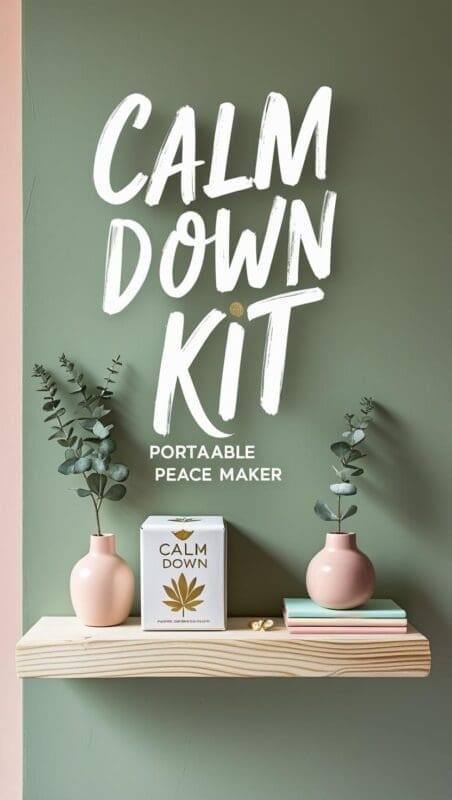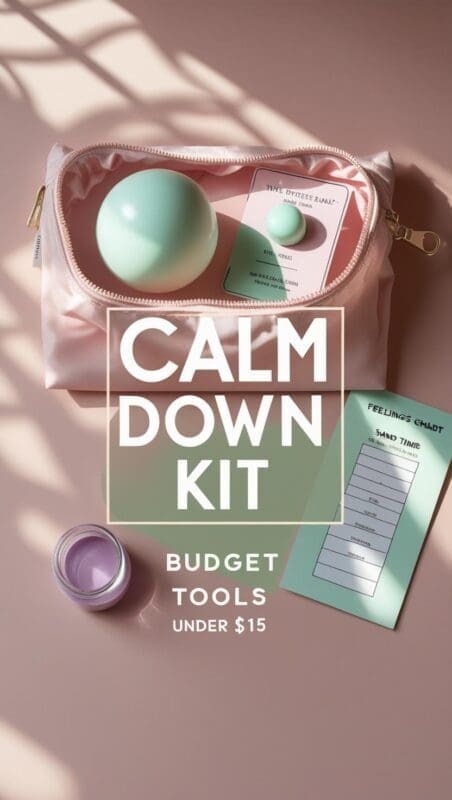I still remember the day Mateo melted down in the hallway. His art project had torn, and the calm-down corner was four doors away. My pockets were empty, my heart racing. That afternoon I vowed never to get caught without a calm down kit again.
Since then I’ve carried a lunch-pail-sized box stuffed with simple tools. The result? Fewer hallway tears, quicker recoveries, and calmer transitions. This deep dive shows you exactly how to build your own kit—for less than the cost of Friday’s coffee run—and teach students to use it responsibly.

Why a Calm Down Kit Belongs in Every K-8 Space
Fixed calm corners are fantastic, but learning rarely stays in one room. Cafeterias echo, art rooms spill paint, buses wobble. Portable kits fill those gaps and do it cheaply.
- Behavior wins. A 2024 pilot in Michigan elementary schools found a 36 % drop in hallway escalations when classrooms used portable SEL kits.
- Stigma drops. A student can grab a kit as casually as a tissue box. No labels, no spotlight.
- Staff peace of mind. Substitute teachers and specialists worry less when a ready-to-go toolkit is within reach.
Think of the calm-down kit as first-aid for feelings: always nearby, rarely dramatic, always appreciated.
Gathering Core Items (Under $15)
You don’t need fancy therapy gadgets. Dollar-store aisles and printer paper will do the job.
| Item | Why It Helps |
|---|---|
| Stress ball | Channel muscle tension into a squeeze and release. |
| Two-minute sand timer | Gives a clear start-and-stop window. |
| Breathing cue card | Visual “inhale → exhale” arrows slow racing breaths. |
| Pocket feelings chart | Helps kids name their emotion quickly. |
| Marble-in-mesh fidget | Quiet, durable, pocket-friendly. |
| Lavender cotton ball in mini jar | Gentle scent lowers pulse rates in lab studies. |
| Tiny notebook + golf pencil | Turning thoughts into words empties the cognitive “stress cup.” |
Total cash outlay at my local dollar store last week: $11.74.
Picking the Right Container
I’ve tried everything from zip bags to shoeboxes. Three options rise to the top:
- Clear zip pouch – ultralight, squeezes in backpacks, lets security staff see contents.
- Latch-lid pencil box – stacks neatly on a shelf, wipes clean.
- Plastic shower caddy – stands upright on specialist carts; great for art or music rooms.
Whichever you choose, label it with a calm icon—cloud, leaf, or soft smile—so even a substitute spots it fast.
Step-by-Step Assembly
- Lay out your tools on a table so nothing hides at the bottom.
- Tape the feelings chart inside the lid for instant visibility.
- Wrap the timer in a sock or felt sleeve; bouncing timers crack easily.
- Slide the notebook flat on top to create a gentle “lid” that keeps pieces from spilling.
Take a quick before-and-after photo. Administrators love evidence of proactive SEL supports.
Teaching Students the Three-Minute Kit Routine
Even the best kit becomes clutter unless students know how to use it. I devote one mini-lesson (about seven minutes) to training.
- Story hook. “Imagine your brain is a soda bottle. What happens when it shakes?”
- Model a reset. Choose a tool, flip the timer, breathe with the cue card, jot a word in the notebook, then rejoin the group.
- Stomp the stigma. Everyone, even the teacher, practices once so no one feels singled out.
- Set the guardrails. Two visits per day unless an adult okays more. Timer keeps things honest.
- Introduce the Kit Captain. A rotating student wipes items and tracks inventory every Friday. Leadership meets responsibility—win-win.
When & Where to Deploy the Kit
- Cafeteria chaos – Noise and crowding spike cortisol. Slip the kit onto your lunch monitor cart.
- Art room frustration – Paint splatters, clay collapses; the kit travels to specials.
- Fire-drill aftermath – Adrenaline lingers; deep-breathing card plus lavender scent = speedy reset.
- Substitute days – New adults can’t manage every trigger. The kit gives them a trusted tool.
Because the kit is small, students can carry it to resource rooms or counseling sessions without fanfare.
Tracking Use and Maintaining Supplies
Data turns “good feeling” anecdotes into hard proof.
- Quick log. Inside the notebook draw three columns: Date – Tool – Ready Y/N. Students check a box on exit.
- Friday review. Scan for patterns. Three red-flag uses in a week? Time for a hallway chat.
- Fortnightly refill. Stress balls pop, cotton balls lose scent. Keep a spare-parts Zip-lock in your desk.
Administrators appreciate that you’re measuring impact, not just decorating with fidgets.
Troubleshooting Common Hurdles
Pieces go missing? Keep dollar-store duplicates in a shoebox. Replace quietly and move on.
Over-enthusiastic visitors? Remind the class that tools are for regulation, not entertainment. Repeat the mini-lesson if needed.
Peer envy? Build two class kits or invite students to create mini home versions during SEL club.
Remember: consistency beats novelty. Better a simple kit used daily than a Pinterest showpiece forgotten on the shelf.
Extend the Strategy to Families
Copy-and-paste this newsletter blurb:
“Ask your child which tool from our Calm Down Kit they liked this week. Challenge them to teach you how to use the sand timer for belly breathing at home!”
Shared language bridges school and home, amplifying progress.
Key Takeaways
A calm down kit is first-aid for feelings: inexpensive, portable, and easy to teach. Stock seven simple items, hold one quick lesson, and empower students to reach for calm wherever learning happens.
Quick Recap — Why Your Calm Down Kit Matters
A portable kit is first-aid for feelings: it follows kids everywhere, costs less than lunch, and teaches self-regulation in real time. Stock a handful of dollar-store tools, walk students through a three-minute routine, and watch hallway meltdowns shrink while instructional minutes grow.
Keep the Calm Momentum Going
- Morning Feelings Check-In – a two-minute routine that sets the emotional tone for the day. → Read the guide
- Coping-Skills Activity Bank – ten low-prep games that make SEL practice fun. → Explore the activities
- Set Up a Full Calm-Down Corner – step-by-step décor and data tips for a permanent space. → See the tutorial


About the Author
Hi, I’m Eve, a former school counselor with a master’s degree in School Psychology and a passionate advocate for children and families navigating sensory challenges. As a mom of children with sensory sensitivities, I deeply understand the journey special-needs parents face, and I dedicate myself to researching and sharing practical solutions to help children thrive and feel comfortable in their bodies. My goal is also to empower counselors, therapists, and psychologists with creative strategies and supportive resources to enrich their everyday practice. When I’m not writing or exploring new therapeutic approaches, you’ll find me spending quality time with my family and continually seeking inspiration from everyday moments.


